
Bipedalism is a form of terrestrial locomotion where an animal moves by means of its two rear limbs or legs. An animal or machine that usually moves in a bipedal manner is known as a biped, meaning 'two feet'. Types of bipedal movement include walking or running and hopping.
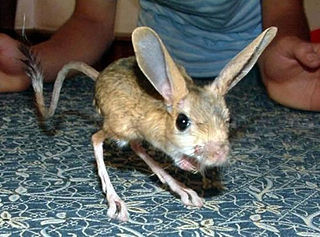
Jerboas are hopping desert rodents found throughout North Africa and Asia, and are members of the family Dipodidae. They tend to live in hot deserts.

Tree-kangaroos are marsupials of the genus Dendrolagus, adapted for arboreal locomotion. They inhabit the tropical rainforests of New Guinea and far northeastern Queensland, Australia along with some of the islands in the region. All tree-kangaroos are considered threatened due to hunting and habitat destruction. They are the only true arboreal macropods.
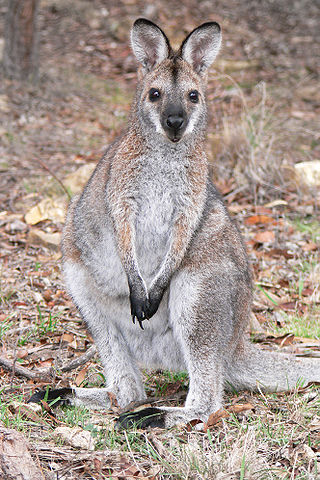
Macropodidae is a family of marsupials that includes kangaroos, wallabies, tree-kangaroos, wallaroos, pademelons, quokkas, and several other groups. These genera are allied to the suborder Macropodiformes, containing other macropods, and are native to the Australian continent, New Guinea and nearby islands.

The banded hare-wallaby, mernine, or munning is a marsupial currently found on the islands of Bernier and Dorre off western Australia. Reintroduced populations have recently been established on islands and fenced mainland sites, including Faure Island and Wadderin Sanctuary near Narembeen in the central wheatbelt.

The term Australian megafauna refers to the megafauna in Australia during the Pleistocene Epoch. Most of these species became extinct during the latter half of the Pleistocene, and the roles of human and climatic factors in their extinction are contested.
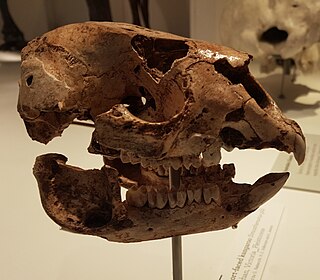
Procoptodon is an extinct genus of giant short-faced (sthenurine) kangaroos that lived in Australia during the Pleistocene Epoch. P. goliah, the largest known kangaroo species that ever existed, stood at about 2 m (6.6 ft). They weighed about 200–240 kg (440–530 lb). Other members of the genus were smaller, however; Procoptodon gilli was the smallest of all of the sthenurine kangaroos, standing approximately 1 m tall.
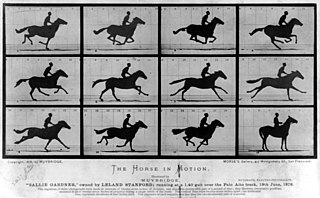
A cursorial organism is one that is adapted specifically to run. An animal can be considered cursorial if it has the ability to run fast or if it can keep a constant speed for a long distance. "Cursorial" is often used to categorize a certain locomotor mode, which is helpful for biologists who examine behaviors of different animals and the way they move in their environment. Cursorial adaptations can be identified by morphological characteristics, physiological characteristics, maximum speed, and how often running is used in life. There is much debate over how to define a cursorial animal specifically. The most accepted definitions include that a cursorial organism could be considered adapted to long-distance running at high speeds or has the ability to accelerate quickly over short distances. Among vertebrates, animals under 1 kg of mass are rarely considered cursorial, and cursorial behaviors and morphology are thought to only occur at relatively large body masses in mammals. There are a few mammals that have been termed "micro-cursors" that are less than 1 kg in mass and have the ability to run faster than other small animals of similar sizes.

Palorchestes is an extinct genus of large terrestrial, herbivorous Australian marsupial of the family Palorchestidae, living from the Miocene through to the Late Pleistocene. Like other palorchestids, it had highly retracted nasal region suggesting that it had a prehensile lip, as well as highly unusual clawed forelimbs that were used to grasp vegetation.

Sthenurus is an extinct genus of kangaroos. With a length around 3 m (10 ft), some species were twice as large as modern extant species. Sthenurus was related to the better-known Procoptodon. The subfamily Sthenurinae is believed to have separated from its sister taxon, the Macropodinae, halfway through the Miocene, and then its population grew during the Pliocene.
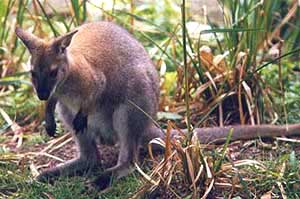
The Macropodiformes, also known as macropods, are one of the three suborders of the large marsupial order Diprotodontia. They may in fact be nested within one of the suborders, Phalangeriformes. Kangaroos, wallabies and allies, bettongs, potoroos and rat kangaroos are all members of this suborder.

Protemnodon is an extinct genus of megafaunal macropodids that existed in Australia, Tasmania, and New Guinea in the Pliocene and Pleistocene. Members of this genus are also called giant kangaroos.

Simosthenurus, also referred to as the short-faced kangaroo, is an extinct genus of megafaunal macropods that existed in Australia, specifically Tasmania, during the Pleistocene. Analysis of Simosthenurus fossils has contributed to the finding that there are three lineages of macropods: Sthenurinae, Macropodinae, and Lagostrophinae. The genus Simosthenurus was among the sthenurines.
The Macropodidae are an extant family of marsupial with the distinction of the ability to move bipedally on the hind legs, sometimes by jumping, as well as quadrupedally. They are herbivores, but some fossil genera like Ekaltadeta are hypothesised to have been carnivores. The taxonomic affiliations within the family and with other groups of marsupials is still in flux.
Macropus pearsoni is an extinct Australian vertebrate species belonging to the family Macropodidae, and is in the same genus (Macropus) as extant kangaroos. M. pearsoni lived during the Pleistocene. It is known from fossil mandibles collected from Pleistocene beds from the Darling Downs in New South Wales, Lake Kanunka in northeastern South Australia, and the Cape York Peninsula. it reached a size similar to Macropus titan, which is a mass of 150 kg.

Simosthenurus occidentalis is a species of sthenurine marsupial that existed in Australia during the Pliocene, becoming extinct in the Pleistocene epoch around 42,000 years ago. It was a large herbivorous biped that resembles large kangaroos, but with a heavier body than modern kangaroos. The structure of the skull and teeth - resembling koalas and panda bears - indicates that it consumed tough vegetation.
Hadronomas is a genus of kangaroo in the subfamily Sthenurinae. There is only one described species, Hadronomas puckridgi, known from various fossil material from the Alcoota Fauna site, and an undescribed species from Lake Kanunka.

Bohra is an extinct genus of macropod from the Plio-Pleistocene of Australia. It is closely related to modern tree kangaroos (Dendrolagus), and like them is thought to have had an arboreal lifestyle, with some species of Bohra substantially exceeding living tree kangaroos in size.
Nombe is an extinct genus of macropodid containing a single species, Nombe nombe. which was formerly classified as a member of the genus Protemnodon. It was native to New Guinea during the Late Pleistocene. It was relatively large in body size and is thought to have been a browser. Phylogenetic analysis suggests that it is a basal member of the subfamily Macropodinae.

Congruus is an extinct genus of macropod known from the Late Pleistocene of Australia. There are two species, Congruus kitcheneri, which was originally described as a species of Wallabia, and Congruus congruus. Specimens are known from Mammoth Cave, Western Australia, the Thylacoleo Caves and the Naracoorte caves in South Australia. Potential material is also known from Eastern Australia. The morphology of the skull and limbs suggests that they were semi-arboreal browsers, moving slowly through trees, though they were larger than and not as specialised for climbing as living tree kangaroos. They are thought to be members of the tribe Macropodini, and close relatives of the extinct genus Protemnodon.




















